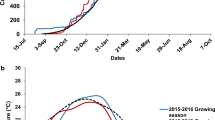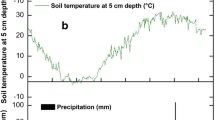Abstract
Recent interests in improving agricultural production while minimizing environmental footprints emphasized the need for research on management strategies that reduce nitrous oxide (N2O) emissions and increase nitrogen-use efficiency (NUE) of cropping systems. This study aimed to evaluate N2O emissions, annualized crop grain yield, emission factor, and yield-scaled- and NUE-scaled N2O emissions under continuous spring wheat (Triticum aestivum L.) (CW) and spring wheat–pea (Pisum sativum L.) (WP) rotations with four N fertilization rates (0, 50, 100, and 150 kg N ha−1). The N2O fluxes peaked immediately after N fertilization, intense precipitation, and snowmelt, which accounted for 75–85% of the total annual flux. Cumulative N2O flux usually increased with increased N fertilization rate in all crop rotations and years. Annualized crop yield and NUE were greater in WP than CW for 0 kg N ha−1 in all years, but the trend reversed with 100 kg N ha−1 in 2013 and 2015. Crop yield maximized at 100 kg N ha−1, but NUE declined linearly with increased N fertilization rate in all crop rotations and years. As N fertilization rate increased, N fertilizer-scaled N2O flux decreased, but NUE-scaled N2O flux increased non-linearly in all years, regardless of crop rotations. The yield-scaled N2O flux decreased from 0 to 50 kg N ha−1 and then increased with increased N fertilization rate. Because of non-significant difference of N2O fluxes between 50 and 100 kg N ha−1, but increased crop yield, N2O emissions can be minimized while dryland crop yields and NUE can be optimized with 100 kg N ha−1, regardless of crop rotations.






Similar content being viewed by others
Abbreviations
- CO2 :
-
Carbon dioxide
- CW:
-
Continuous spring wheat
- GHG:
-
Greenhouse gas
- GWP:
-
Global warming potential
- N2O:
-
Nitrous oxide
- NUE:
-
N-use efficiency
- WP:
-
Spring wheat–pea rotation
- WFPS:
-
Water-filled pore space
References
Amos B, Arkebauer TJ, Doran JW (2005) Soil surface fluxes of greenhouse gases in an irrigated maize-based agroecosystem. Soil Sci Soc Am J 69:387–395
Barton L, Kiese R, Gutter D, Butter-Bahl K, Buck R, Hinz C, Murphy DV (2008) Nitrous oxide emissions from a cropped soil in a semiarid climate. Global Change Biol 14:177–192
Cui F, Yan G, Zhou Z, Zheng X, Deng J (2012) Annual emissions of nitrous oxide and nitric oxide from a wheat-maize cropping system on a silt loam calcareous soil in the North China Plain. Soil Biol Biochem 48:10–19
Curtin D, Wang H, Selles F, McConkey BG, Campbell CA (2000) Tillage effects on carbon fluxes in continuous wheat and fallow-wheat rotations. Soil Sci Soc Am J 64:2080–2086
Drury CF, Reynolds WD, Tan CS, Welacky TW, Calder W, McLaughlin NB (2006) Emissions of nitrous oxide and carbon dioxide: influence of tillage type and nitrogen placement depth. Soil Sci Soc Am J 70:570–581
Dusenbury MP, Engel RE, Miller PR, Lemke RL, Wallander R (2008) Nitrous oxide emissions from a northern Great Plains soil as influenced by nitrogen management and cropping systems. J Environ Qual 37:542–550
Food and Agriculture Organization (FAO) (2003) World agriculture. Towards 2015–2030. An FAO perspective. Rome, Italy
Hatfield JL (2014) Soil and nitrogen management to reduce nitrous oxide emissions. In: Chatterjee A, Clay D (eds) Soil fertility and management in agroecosystems. American Society of Agronomy and Soil Science Society of America, Madison, pp 91–108
Heggenstaller AH, Moore KJ, Liebman M, Anex RP (2009) Nitrogen influences biomass and nutrient partitioning by perennial, warm-season grasses. Agron J 101:1363–1371
Intergovernmental Panel on Climate Change (IPCC) (2013) Climate change 2013. The physical science basis. 5th Assessment Report. Cambridge University Press, Cambridge, UK
Kuo S, Sainju UM, Jellum EJ (1997) Winter cover cropping influence on nitrogen in soil. Soil Sci Soc Am J 61:1392–1399
Lemke RL, Izaurralde RC, Nyborg M, Solberg ED (1999) Tillage and nitrogen source influence soil-emitted nitrous oxide in the Alberta Parkland region. Can J Soil Sci 79:15–24
Lenssen AW, Sainju UM, Jabro JD, Allen BL, Stevens WB (2018) Dryland pea production and water use responses to tillage, crop rotation, and weed management practice. Agron J 110:1843–1853
Liebig MA, Tanaka DL, Gross JR (2010) Fallow effects on soil carbon and greenhouse gas flux in central North Dakota. Soil Sci Soc Am J 74:358–365
Littell RC, Milliken GA, Stroup WW, Wolfinger RD, Schabenberge O (2006) SAS for mixed models. SAS Inst. Inc., Cary
Miller PR, Gan Y, McConkey BG, McDonald CL (2003) Pulse crops for the northern Great Plains: I. Grain productivity and residual effects on soil water and nitrogen. Agron J 95:972–979
Mosier AR, Parton WJ, Valentino DW, Ojince DS, Schimel DS, Hienemeyer N (1997) CH4 and N2O fluxes in the Colorado shortgrass steppe. II. Long-term impact of land-use change. Global Biogeochem Cycles 11:29–42
Mosier AR, Halvorson AD, Ruele CA, Liu XJ (2006) Net global warming potential and greenhouse gas intensity in irrigated cropping systems in northeastern Colorado. J Environ Qual 35:1584–1598
O’Donovan JT, Turkington TK, Edney MJ, Clayton GW, McKenzie RH, Juskiw PE, Lanfond GP, Grant CA, Brandt S, Harker KN, Johnson EN, May WE (2011) Seeding rate, nitrogen rate, and cultivar effects on malting barley production. Agron J 103:706–709
Omonode RA, Smith DR, Gal A, Vyn TJ (2011) Soil nitrous oxide emissions following three decades of tillage and rotation treatments. Soil Sci Soc Am J 75:152–163
Omonode RA, Kovas P, Vyn TJ (2015) Tillage and nitrogen rate effect on area- and yield-scaled nitrous oxide emissions from preplant anhydrous ammonia. Agron J 107:605–614
Parkin TB, Kaspar TC (2006) Nitrous oxide emissions from corn-soybean systems in the Midwest. J Environ Qual 35:1496–1506
Parkin TB, Venterea RT (2010) Chamber-based trace gas flux measurements. In: Follett RP (ed) Sampling protocols, pp 3-1 to 3-39. www.ars.usda.gov/research/GRACEnet
Qi S, Hu C, Ahuja LR, Zhang X, Wang Y (2006) Nitrous oxide emissions from uplands in northern China. In: DelGrosso S, Ahuja LR, Parton W (eds) Synthesis and modeling of greenhouse gas emissions and carbon storage in agricultural and forest systems to guide mitigation and adaptation. Advances in agricultural system modeling, vol 6. American Society of Agronomy, Soil Science Society of American, Madison, Wisconsin, USA, pp 1–20
Robertson GP, Vitousek PM (2009) Nitrogen in agriculture: balancing the cost of an essential resource. Annu Rev Environ Resour 34:97–125
Robertson GP, Paul E, Harwood R (2000) Greenhouse gases in intensive agriculture: contribution of individual gases to the radiative forcing of the atmosphere. Science 289:1922–1925
Sainju UM (2013) Tillage, cropping sequence, and nitrogen fertilization influence dryland soil nitrogen. Agron J 105:1253–1263
Sainju UM, Jabro JD, Caesar-TonThat T (2010) Tillage, cropping sequence, and nitrogen fertilization effects on dryland soil carbon dioxide emission and carbon content. J Environ Qual 37:98–106
Sainju UM, Lenssen AW, Caesar-TonThat T, Jabro JD, Lartey RT, Evans RG, Allen BL (2011) Dryland residue and soil organic matter as influenced by tillage, crop rotation, and cultural practice. Plant Soil 338:27–41
Sainju UM, Caesar-TonThat T, Lenssen AW, Barsotti JL (2012) Dryland soil greenhouse gas emissions affected by cropping sequence and nitrogen fertilization. Soil Sci Soc Am J 76:1741–1757
Sainju UM, Lenssen AW, Barsotti JL (2013) Dryland malt barley yield and quality affected by tillage, cropping sequence, and nitrogen fertilization. Agron J 105:329–340
Sainju UM, Allen BL, Caesar-TonThat T, Lenssen AW (2015) Dryland soil chemical properties and crop yields affected by long-term tillage and cropping sequence. SpringerPlus 4:230. https://doi.org/10.1186/s40064-015-1122-4
Smith P, Martino D, Cai Z, Gwary D, Janzen H, Kumar P, McCarl B, Ogle S, O’Mara F, Rice C, Scholes B, Sirotenko D (2007) Agriculture. In: Metz B (ed) Climate change 2007: mitigation. Cambridge Univ. Press, Cambridge, pp 497–540
Van Groenigen J, Velthol G, Oenema O, Van Groenigen K, Van Kessel C (2010) Towards an agronomic assessment of N2O emissions: a case study for arable crops. Eur J Soil Sci 61:903–913
Varvel GE, Peterson TA (1990) Residual soil nitrogen as affected by continuous, two-year, and four-year crop rotations. Agron J 82: 958–962
Venterea RT, Burger M, Spikes KA (2005) Nitrogen oxide and methane emissions under varying tillage and fertilizer management. J Environ Qual 34:1467–1477
Wagner-Riddle C, Hu QC, Van Bochave E, Jayasundara S (2008) Linking nitrous oxide flux during spring thaw to nitrate-denitrification in the soil profile. Soil Sci Soc Am J 72:908–916
Wilson TM, McGowen B, Mullock J, Arnall DB, Warren JG (2015) Nitrous oxide emissions from continuous winter wheat in the southern Great Plains. Agron J 107:1878–1884
Acknowledgements
We thank Michael Johnson and Mark Gaffri for their help in the management of experimental field plots and Joy Barsotti, Jana Seright, and Emily Reese for collecting gas, soil, and crop samples in the field and analyzing in the laboratory.
Author information
Authors and Affiliations
Corresponding author
Additional information
Publisher's Note
Springer Nature remains neutral with regard to jurisdictional claims in published maps and institutional affiliations.
Mention of trade names or commercial products in this publication is solely for the purpose of providing specific information and does not imply recommendation or endorsement by USDA. The USDA is an equal opportunity employer.
Rights and permissions
About this article
Cite this article
Sainju, U.M., Ghimire, R., Mishra, U. et al. Reducing nitrous oxide emissions and optimizing nitrogen-use efficiency in dryland crop rotations with different nitrogen rates. Nutr Cycl Agroecosyst 116, 381–395 (2020). https://doi.org/10.1007/s10705-020-10046-0
Received:
Accepted:
Published:
Issue Date:
DOI: https://doi.org/10.1007/s10705-020-10046-0




